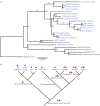Adaptive evolution of vertebrate-type cryptochrome in the ancestors of Hymenoptera
- PMID: 23221878
- PMCID: PMC3565517
- DOI: 10.1098/rsbl.2012.0958
Adaptive evolution of vertebrate-type cryptochrome in the ancestors of Hymenoptera
Abstract
One of the most mysterious aspects of insect clock mechanisms is that some insects, including Hymenoptera and Tribolium, only express a vertebrate-type cryptochrome (cry2). It is unknown whether or not cry2 underwent adaptive evolution in these insects. In the present study, we cloned and sequenced the full-length cry2 from a fig pollinator species, Ceratosolen solmsi (Hymenoptera: Chalcidoidea: Agaonidae), and examined the molecular evolution and daily expression of this gene. Our results suggest that cry2 underwent positive selection in the branch leading to hymenopteran insects. The function of CRY2 might have been fixed since undergoing natural selection in the ancestor of Hymenoptera. Male pollinators showed stronger rhythmicity in the host figs, which reflect an adaptation to their life cycles.
Figures


Similar articles
-
Adaptive evolution of the circadian gene timeout in insects.Sci Rep. 2014 Feb 27;4:4212. doi: 10.1038/srep04212. Sci Rep. 2014. PMID: 24572761 Free PMC article.
-
Evolution and expression plasticity of opsin genes in a fig pollinator, Ceratosolen solmsi.PLoS One. 2013;8(1):e53907. doi: 10.1371/journal.pone.0053907. Epub 2013 Jan 16. PLoS One. 2013. PMID: 23342036 Free PMC article.
-
Insect cryptochromes: gene duplication and loss define diverse ways to construct insect circadian clocks.Mol Biol Evol. 2007 Apr;24(4):948-55. doi: 10.1093/molbev/msm011. Epub 2007 Jan 22. Mol Biol Evol. 2007. PMID: 17244599
-
Expression and evolutionary divergence of the non-conventional olfactory receptor in four species of fig wasp associated with one species of fig.BMC Evol Biol. 2009 Feb 20;9:43. doi: 10.1186/1471-2148-9-43. BMC Evol Biol. 2009. PMID: 19232102 Free PMC article.
-
Phylogeny and oscillating expression of period and cryptochrome in short and long photoperiods suggest a conserved function in Nasonia vitripennis.Chronobiol Int. 2014 Jul;31(6):749-60. doi: 10.3109/07420528.2014.880451. Epub 2014 Apr 23. Chronobiol Int. 2014. PMID: 24758403 Free PMC article.
Cited by
-
Up-regulation of cryptochrome 1 gene expression in cotton bollworm (Helicoverpa armigera) during migration over the Bohai Sea.PeerJ. 2019 Nov 15;7:e8071. doi: 10.7717/peerj.8071. eCollection 2019. PeerJ. 2019. PMID: 31741806 Free PMC article.
-
Adaptive evolution of the circadian gene timeout in insects.Sci Rep. 2014 Feb 27;4:4212. doi: 10.1038/srep04212. Sci Rep. 2014. PMID: 24572761 Free PMC article.
References
-
- Ozturk N, Song SH, Ozgur S, Selby CP, Morrison L, Partch C, Zhong D, Sancar A. 2007. Structure and function of animal cryptochromes. Cold Spring Harb. Symp. Quant. Biol. 72, 119–13110.1101/sqb.2007.72.015 (doi:10.1101/sqb.2007.72.015) - DOI - DOI - PubMed
-
- Rubin EB, Shemesh Y, Cohen M, Elgavish S, Robertson HM, Bloch G. 2006. Molecular and phylogenetic analyses reveal mammalian-like clockwork in the honey bee (Apis mellifera) and shed new light on the molecular evolution of the circadian clock. Genome Res. 16, 1352–136510.1101/gr.5094806 (doi:10.1101/gr.5094806) - DOI - DOI - PMC - PubMed
-
- Yuan Q, Metterville D, Briscoe AD, Reppert SM. 2007. Insect cryptochromes: gene duplication and loss define diverse ways to construct insect circadian clocks. Mol. Biol. Evol. 24, 948–95510.1093/molbev/msm011 (doi:10.1093/molbev/msm011) - DOI - DOI - PubMed
-
- Zhu H, Yuan Q, Froy O, Casselman A, Reppert SM. 2005. The two CRYs of the butterfly. Curr. Biol. 15, R953–R95410.1016/j.cub.2005.11.030 (doi:10.1016/j.cub.2005.11.030) - DOI - DOI - PubMed
-
- Tomioka K, Matsumoto A. 2010. A comparative view of insect circadian clock systems. Cell. Mol. Life Sci. 67, 1397–140610.1007/s00018-009-0232-y (doi:10.1007/s00018-009-0232-y) - DOI - DOI - PMC - PubMed
Publication types
MeSH terms
Substances
Associated data
- Actions
LinkOut - more resources
Full Text Sources
Other Literature Sources

